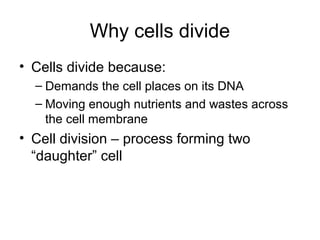
Why Cells Divide
- 1. Why cells divide • Cells divide because: – Demands the cell places on its DNA – Moving enough nutrients and wastes across the cell membrane • Cell division – process forming two “daughter” cell
- 2. Cell Division • 1st stage – mitosis (division of the nucleus) • 2nd stage – cytokinesis – division of cytoplasm • Chromosomes – contain DNA and proteins • Before cell division, each chromosome replicates and consists of two “sister” chromatids
- 3. Cont. • Each pair of chromatids is attached at the centromere, which will separate during cell division and each new cell will have identical copies of the old cell • Cell cycle: – Cell grows – Prepares for division (replicates DNA) – Divides into two daughter cells – Cycle begins again
- 5. Mitosis • 4 phases: • Prophase – chromatin condense into chromosomes, centriole separates and a spindle begins to form, the nuclear envelope breaks down • Metaphase – chromosomes line up across center of cell, connected to spindle fiber (helps separate chromosomes) at centromere
- 6. Cont. • Anaphase – mitosis: centromeres that join the sister chromatids split, chromatids separate and become individual chromosomes (two groups) • Telophase – chromosomes disperse into tangle of dense material, nuclear envelope re-forms around chromosome clusters, spindle breaks apart, nucleolus is visible in daughter nucleus.
- 8. Cont. • Cytokinesis – division of cytoplasm in the M phase, cell membrane folds into cell pinching cell into two equal parts containing nucleus and cytoplasmic organelles
- 10. Cell regulating • Cyclin – (protein) regulates the timing of the cell cycle in eukaryotic cells • Regulation – internal (replication) and external (growth) are controlled by proteins • Cancer – uncontrolled cell growth (disease of the cell cycle)
- 11. Meiosis • Homologous – two sets of chromosomes (set from female, set from male), two complete sets of chromosomes and two complete sets of genes • Diploid – “two sets” cell that contains homologous chromosomes (2N=8) • Haploid – “one set” (N=4)
- 12. Phases of Meiosis • Meiosis – process of reduction division in which the number of chromosomes per cell is cut in half through the separation of homologous chromosomes in a diploid cell • Divided into two distinct phases • Meiosis I and II
- 13. Meiosis I • Prophase I – each chromosome pairs with its corresponding homologous chromosome to form a tetrad (4 chromatids) • Metaphase I – spindle fibers attach to the chromosomes • Anaphase I – fibers pull the homologous chromosomes toward opposite ends of the cells
- 14. Cont. • Telophase I and cytokinesis – nuclear membrane form and the cell separates into two haploid (N) daughter cells, each with half the number of chromosomes as the original cells • Crossing-over – exchange of chromatids which results in the exchange of alleles between homologous chromosomes and produces new combinations of alleles
- 16. Meiosis II • Prophase II - two haploid (N) daughter cells, each with half the number of chromosomes as the original cells • Metaphase II – chromosomes line up in a similar way to the metaphase stage of mitosis • Anaphase – sister chromatids separate and move toward opposite ends of the cell
- 17. Cont. • Telophase and cytokinesis – Meiosis II results in 4 haploid (N) daughter cells (2 chromosomes each)
- 19. Gamete Formation • Males – haploid gamete is the sperm • Females – only one haploid gamete, egg • Comparing mitosis and meiosis: – Mitosis produces 2 genetically identical diploid (2N) daughter cells: allows the body to grow and replace cells – Meiosis produces four genetically different haploid cells: used in sexual reproduction
- 20. Mitosis Meiosis Asexual Reproduction Sexual Reproduction Produces two identical cells Produces four different cells New cell contains a full set New cells contain half the (diploid) of chromosomes number of chromosomes (haploid) DNA replication once during DNA replication once during interphase interphase before Meiosis 1 One nuclear division Two nuclear divisions No crossing over – no genetic Crossing over during prophase variation 1 to ensure genetic variation Sister chromatids pulled to Homologous chromosomes opposite poles during move to opposite poles during anaphase resulting in 2 anaphase 1. Centromeres hold identical cells. The centromere sister chromatids together splits ensuring that identical resulting in non-identical cells chromatids are pulled to the opposite poles Occurs in all types of body Occurs only in sex cells cells (egg & sperm) Purpose: cell growth and Purpose: produce sex cells repair